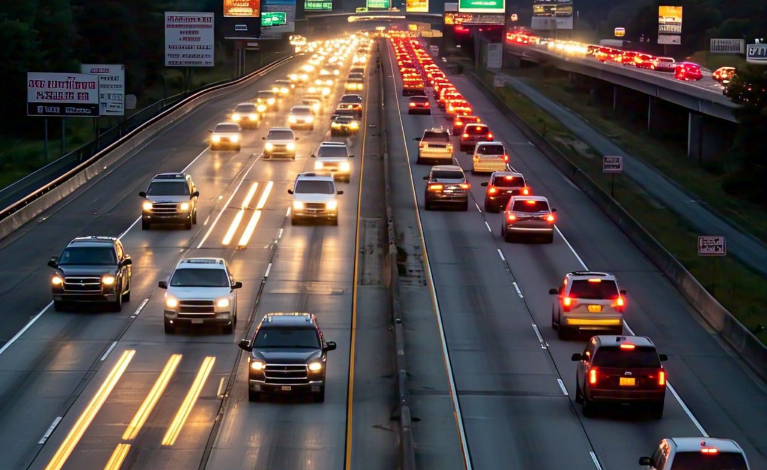Understanding I-81 Traffic: Tips to Stay Ahead on the Road

If you’ve ever driven along Interstate 81, you know how tricky I-81 traffic can get. This highway stretches across six states and covers over 850 miles, connecting busy cities and small towns. From trucks hauling goods to daily commuters, this road is always buzzing with activity.
Traffic on I-81 can be unpredictable, especially during rush hours or bad weather. Knowing how to prepare for your journey can save you a lot of stress and time. In this blog, we’ll dive into everything you need to know about I-81 traffic—from understanding hotspots to tips on navigating it safely.
Table of Contents
What Is I-81 Traffic and Why Does It Matter

Interstate 81, or I-81, is one of the busiest highways in the United States. It spans six states, connecting major cities and rural areas. Traffic on this highway is important because it impacts daily commuters, truck drivers, and vacationers alike.
Driving on I-81 can sometimes feel overwhelming. With so many vehicles sharing the road, delays can happen at any time. Accidents, construction zones, and rush-hour congestion are common problems drivers face. Knowing the ins and outs of I-81 traffic can help you plan better and make your trip less stressful.
Why Is I-81 Traffic Often Heavy
The high volume of trucks is one of the main reasons for heavy traffic on I-81. This highway is a major route for transporting goods across the eastern United States. Large trucks share the road with passenger vehicles, making it feel crowded during peak times.
Construction projects also add to the delays. While these improvements are meant to make the highway safer, they can cause lane closures and slower speeds. Additionally, bad weather, like heavy rain or snow, can create even more issues for drivers.
How to Avoid Peak I-81 Traffic Hours
Choosing the right time to travel can save you hours of frustration. Early mornings and late evenings are usually less busy, especially on weekdays. Weekends tend to have more traffic due to leisure travel, so it’s best to plan accordingly.
Checking real-time traffic updates before heading out is always a good idea. Apps and websites with live data can help you spot delays and choose alternative routes. A little planning goes a long way when trying to avoid the worst of I-81 traffic.
Best Tools for Tracking I-81 Traffic in Real-Time
Technology can be your best friend when navigating I-81. Real-time traffic apps like Waze or Google Maps are excellent tools for staying updated. These platforms show live traffic conditions and suggest faster routes if there are delays.
Many drivers also use traffic cameras placed along I-81 to get a visual update. These cameras provide a live view of current road conditions, helping you prepare for what’s ahead. Staying informed can make your journey smoother and more predictable.
Sub-Headings for Last Two:
Tips for Safe Driving on I-81
- Avoid distractions and focus on the road.
- Maintain a safe distance from other vehicles.
- Prepare for sudden stops in high-traffic areas.
Weather’s Impact on I-81 Traffic
- Winter storms can cause icy roads.
- Heavy rain often reduces visibility.
- Check forecasts before starting your trip.
Why I-81 Traffic Can Be Challenging
I-81 traffic is often busy because it’s a major highway connecting six states, including Tennessee, Virginia, and Pennsylvania. It is a vital route for commuters, travelers, and truckers transporting goods across the eastern U.S. This heavy usage makes it one of the busiest highways in the country.
The challenge lies in the mix of traffic. Large trucks, passenger vehicles, and road work zones all contribute to congestion. Even small accidents or bad weather can lead to long delays. Understanding these factors can help you navigate the highway with ease.
Best Times to Avoid I-81 Traffic

If you want to avoid getting stuck in traffic, plan your trip during off-peak hours. Early mornings and late evenings on weekdays are often quieter times to travel. Weekends tend to see heavier traffic due to leisure trips and family outings.
It’s also important to check for special events or festivals happening in cities along the I-81 corridor. These events can cause unexpected spikes in traffic. Checking live traffic updates before starting your journey can help you pick the best times to hit the road.
Common Causes of I-81 Traffic Delays
Truck Traffic: I-81 is a major trucking corridor. Heavy trucks can slow down traffic, especially on steep hills.
Road Work: Construction projects are common along the highway. They improve safety but often cause lane closures.
Weather Issues: Rain, snow, and fog frequently disrupt traffic flow, especially during winter months.
By knowing these common causes, you can plan ahead and make your trip smoother.
How to Stay Updated on I-81 Traffic Conditions
In the present computerized age, remaining informed is simpler than at any other time. Apps like Google Maps and Waze offer real-time updates on traffic conditions, including accidents and construction zones.
Many drivers also rely on traffic cameras to check road conditions in real-time. Websites dedicated to I-81 traffic provide access to live camera feeds, helping drivers see potential delays before they start driving. Combining these tools can save you time and frustration.
Safety Tips for Driving on I-81
Driving safely on I-81 requires extra care because of the high volume of traffic. Here are some tips:
- Always maintain a safe distance from large trucks.
- Stay away from interruptions, for example, messaging or eating while at the same time driving.
- Be extra cautious in construction zones and follow posted speed limits.
- Check your vehicle’s condition, especially before a long trip.
How to Handle Weather-Related Traffic on I-81
Weather can have a huge impact on I-81 traffic. During winter, snow and ice often create dangerous driving conditions. Fog is another common issue, especially in the mountainous regions of Virginia and Pennsylvania.
To stay safe during bad weather, reduce your speed and use headlights for better visibility. Keep an eye on weather alerts and road updates to know what to expect. If conceivable, postpone your excursion until conditions move along.
Exploring Alternate Routes to Avoid I-81 Traffic
Sometimes, taking an alternate route can save you time and stress. Secondary highways, such as U.S. Route 11, often run parallel to I-81 and are less congested. These routes may take slightly longer but can be a good option during heavy traffic.
Before choosing an alternate route, use a navigation app to check travel times. Apps like Waze can help you decide if taking a detour is worth it. Flexibility is key when trying to avoid delays.
Emergency Tips for I-81 Drivers
Unexpected events, like accidents or vehicle breakdowns, can happen anytime. Here’s how to be prepared:
- Always carry an emergency kit with water, snacks, and first-aid supplies.
- Have a phone charger and flashlight in your car.
- Know the locations of nearby rest stops and gas stations.
Staying prepared for emergencies can make a big difference, especially if you’re stuck in traffic for long periods.
Best Apps to Track I-81 Traffic
Using the right tools can make your I-81 trip easier. Apps like Google Maps, Waze, and WeatherBug are great for tracking traffic and weather conditions. They give real-time updates, helping you avoid traffic jams and plan your route better.
Another useful tool is 511 services available in many states. These services provide live traffic cameras and incident reports. With these tools, staying informed on I-81 traffic is just a tap away.
Alternate Routes to Avoid I-81 Congestion
Sometimes, the best way to deal with I-81 traffic is to avoid it. U.S. Route 11 is a reliable alternate route that runs parallel to I-81. It’s less crowded and offers scenic views.
For longer trips, consider taking other interstates like I-95 or I-40, depending on your destination. Always check traffic conditions before deciding on an alternate route to ensure a smooth drive.
Preparing for Emergencies on I-81

Emergencies can happen anytime, so it’s good to be prepared. Keep an emergency kit in your car with essentials like water, snacks, a flashlight, and a phone charger. Knowing where nearby rest stops and gas stations are can also be helpful.
Ensure your vehicle is looking great prior to beginning your excursion.Check your tires, brakes, and fuel levels. Staying prepared keeps you safe and reduces stress during unexpected situations.
Conclusion
I-81 traffic can feel frustrating, but planning ahead can make a big difference. Whether it’s checking live updates, avoiding peak travel times, or taking alternate routes, these small steps help you save time and stress. Remember, every journey on I-81 is smoother when you’re prepared and patient.
Always stay safe and aware of your surroundings. Keep your car in good condition, follow traffic rules, and watch out for weather changes. With the tips shared in this blog, you can handle I-81 traffic like a pro and enjoy a smoother, safer drive.
FAQs
Q: What is the best time to avoid I-81 traffic?
A: Early mornings and late evenings during weekdays are usually the best times to avoid heavy traffic.
Q: How can I check live I-81 traffic updates?
A: You can use apps like Google Maps or Waze, or visit websites with live traffic cameras for real-time updates.
Q: What are the main causes of I-81 traffic delays?
A: Truck traffic, road construction, and bad weather are the main reasons for delays on I-81.
Q: Are there alternate routes to avoid I-81 traffic?
A: Yes, U.S. Route 11 often runs parallel to I-81 and can be a good alternative during heavy traffic.
Q: How do I prepare for emergencies on I-81?
A: Always carry an emergency kit with water, snacks, a flashlight, and a phone charger. Be aware of nearby rest stops and gas stations.





